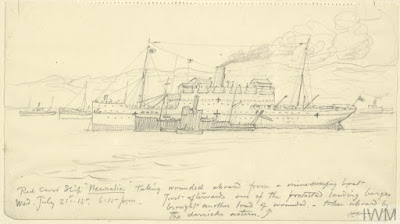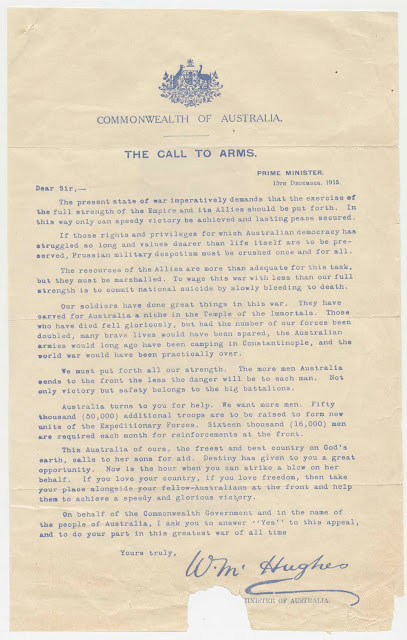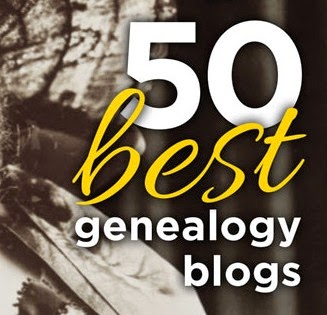Tuesday, December 29, 2020
Sapper Douglas Morpeth of Mar Lodge
Monday, November 30, 2020
Thunderboxes, troops, for the use of
Wednesday, November 11, 2020
Mystery Man: Doctor J Hughston
The Essendon Gazette of 10 June 1915, in its For King and Country column, carried the photo of a young man in civilian dress with a subheading. There was no article to explain the reference or nor does his name appear on the Roll Of Honour either then or in the succeeding three years of the War. Who was this man and why did the Essendon Gazette think that this could be of interest to readers?
Never one to ignore a challenge, Marilyn Kenny set out to solve the mystery of this youthful doctor. She details her findings in an article Mystery Man: Major Johnston Hughston RAMC.
Monday, September 14, 2020
2nd Aircraft Mechanic Harry Nelson and the widow's fight
Harry Nelson, fruiterer and cyclist of McConnell St, Kensington, enlisted in October 1917, and embarked in May 1918. In 1917, between his enlistment and embarkation, Harry married. Harry and his bride, Florence, evidently anticipated their vows, as their son was six weeks old when Harry left the country.
Arriving in England in mid-1918, Harry was a sitting duck for the influenza sweeping though military encampments. Harry died of illness on 22 October 1918, barely three weeks before the Armistice.
In his new story, Rod Martin describes the difficulties Florence had getting souvenirs and assets to which she was entitled. It is not certain if she ever did as Harry's family and lawyer set out to thwart her. See the full story, so far as we know it, here.
Sunday, September 13, 2020
The Empire Called 10th Anniversary of Blogging
The date of the 10th Anniversary of the commencement of The Empire Called and I Answered blog has come and gone earlier in the year, as my new Covid-normal is to forgetting things when every day is Groundhog Day, but it is still worth noting. The blog was created as a companion to my webpage of the same name, which I launched later in 2010. I use the blog to to draw attention to new additions to the website, to record new Sources for individuals who participated in the Great War (See the Tags on the right hand column), to note new books of local interest.
The blog and website record the volunteers from Essendon, Moonee Ponds, Ascot Vale, Flemington, Kensington and Newmarket, with occasion others who had grown up in the local area and had their names recorded on local honour boards. There are about 4500 names in the database, so worth a look if you had family in the area at the time of the Great War.
In addition to a page for each individual, such as Private George Abbott, there are stories about the Home Front - covering individuals, such as Mayor John Goldsworthy who created the Essendon Town Hall Honour Boards; and organisations such as the Cheer-up Brigade. There are links to pages where there are collections of photos from private albums, and pages where you can see what volunteers left from what street addresses. There is a link to Acknowledgements for those people who have contributed photos, postcards, and documents, and in some cases stories. Two people in particular have made significant contributions - Rod Martin and Marilyn Kenny - who have been great supporters of the project. I thank them and all of the contributors. Any further contributions of photos, postcards and documents (scans only of course) are very welcome.
I invite you all to have a good look around The Empire Called and I Answered, while I open a bottle of champage, which of course I will drink by myself while in lockdown.
Friday, June 5, 2020
Jim Raff, machine gunner of Kensington
 |
| Machine gunners in training at Seymour, 1916. AWM P08299.002. |
Rod Martin explains the role of Jim's crew, the 10th Machine Gun Company, and later the 22nd MGC, in battles in France and Belgium. You can read Jim's full story here.
Tuesday, May 5, 2020
HMAT Boonah in Quarantine on Torrens Island, 1919
 |
| Quarantined on Torrens Island, near Adelaide, Sergeant Norman Gillies in the centre. |
Thursday, April 30, 2020
The Call to Arms, 1916 digitised in full
I posted about this series of documents, B6525 in the National Archives of Australia back in 2014. At the time, only some of the forms had been digitised. Having another look at them today, I find the whole series digitised, as well as another series, B6526, which are the name index cards for Series B6525. The cards are sorted alphabetically in four sections, according to whatever reason was, or was not given. Not too hard to match up with the folders in B6525.
Use the Advanced Search option and pop either number in the Series box. In the results form, click on the number of records - ie, in B6525 you will see 29. Click on that to get the full list. B6526 shows 4 items.
James Boyne of 34 Eltham St, Flemington did not get away with a two line reason for not enlisting. The Committee required a more detailed explanation. His letter follows his form.
Seeing that enlistment was still voluntary, these men could not be forced to enlist, but it all added to the pressure.
So if you are wondering why some people didn't enlist, the answer could be here.
Saturday, April 18, 2020
Troopship Boonah and the Spanish flu
 |
| HMAT Boonah, courtesy of Wikipedia article on the Boonah Crisis. |
Thursday, April 16, 2020
The Aftermath of Lone Pine - Private Leslie Oakley
 |
| Hospital Ship Neuralia 1915 (IWM ART 4405) |
Saturday, February 29, 2020
A Teacher's Bequest
Saturday, February 22, 2020
Flying Officer William Edward Bruce Neilson
After last month's story about James Charles Outhred, who was a fellow member of No 3 Squadron, AFC, Rod Martin tells the story of William Edward Bruce Neilson. While both Outhred and Neilson enlisted at much the same time, embarked on the Ulysses together, and were appointed Second Class Air Mechanics, their experience with their squadron was quite different, Outhred being channelled into Wireless training, and Neilson into mechanics, and later aerial gunnery. By the end of the war he qualified as a pilot. Rod Martin tells the story of Flying Officer WEB Neilson.
Sunday, January 19, 2020
2 Air Mechanic James Charles Outhred, AFC
What do the Red Baron, an empty grave in Moe and Air Mechanic Outhred have in common with 3 Australian Flying Squadron? Rod Martin tells you in his story of 2 Air Mechanic James Charles Outhred. You can see his story here. http://empirecall.pbworks.com/w/page/63677298/Outhred-J-C-Pte-582
Saturday, January 18, 2020
Neil Neilson answers the Call to Arms
 |
| State Library South Australia. https://digital.collections.slsa.sa.gov.au/nodes/view/2434 |
Neil Neilson of 39 Mt Alexander Rd, Flemington, driver, answered that call. He was a fairly slight figure, one of eleven children, but he responded to Hughes' appeal and enlisted on 4 January 1916, just a few weeks after the appeal was made.
Rod Martin tells the story of a fairly troublesome young man who managed to overcome his difficulties with the army and became a reliable member of 15 Battery, 5 Field Artillery Brigade as Gunner Neil Robert Neilson. Neilson died after a gas attack, on 8 June 1918.





















